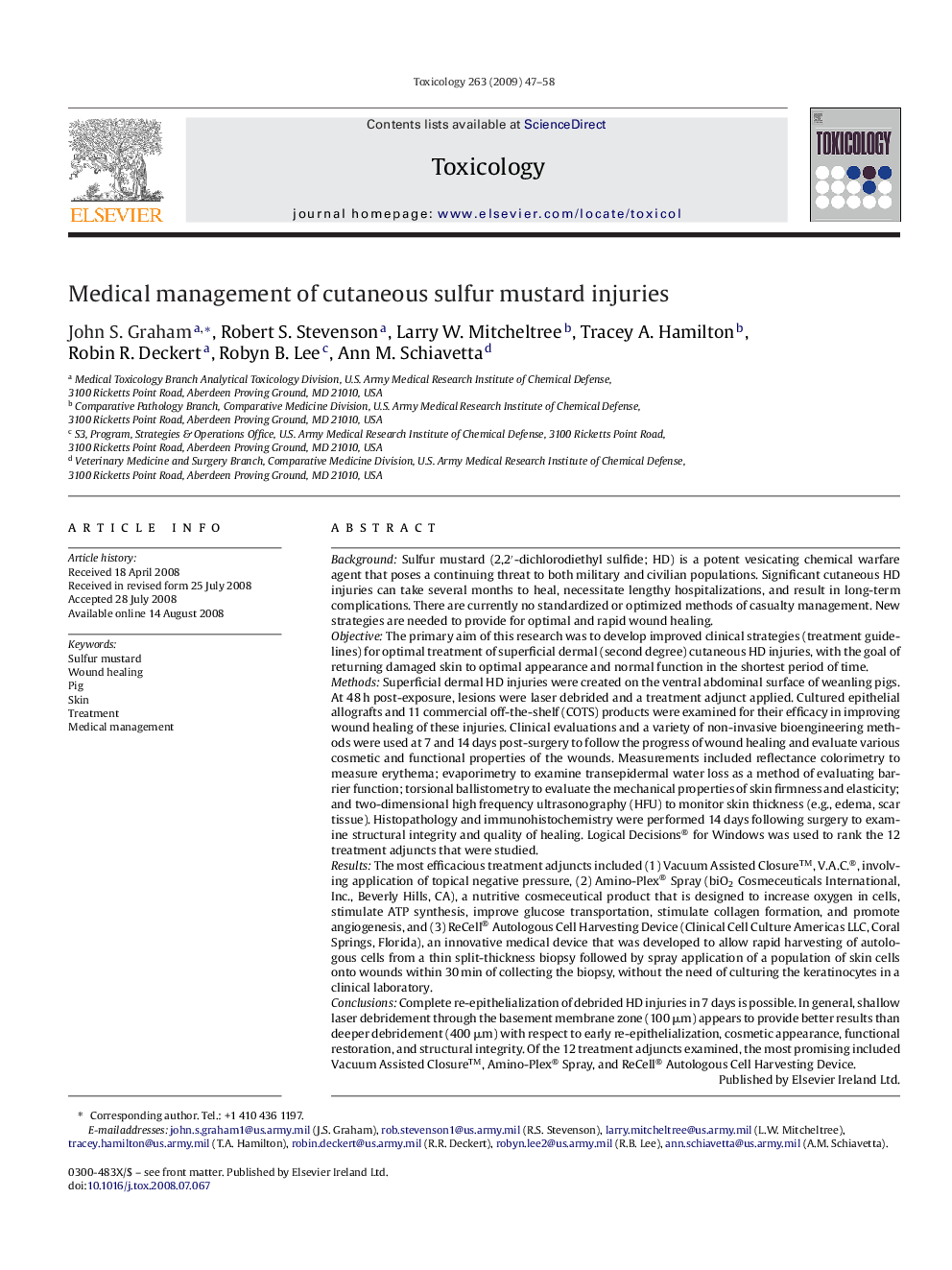| کد مقاله | کد نشریه | سال انتشار | مقاله انگلیسی | نسخه تمام متن |
|---|---|---|---|---|
| 2596698 | 1132543 | 2009 | 12 صفحه PDF | دانلود رایگان |

BackgroundSulfur mustard (2,2′-dichlorodiethyl sulfide; HD) is a potent vesicating chemical warfare agent that poses a continuing threat to both military and civilian populations. Significant cutaneous HD injuries can take several months to heal, necessitate lengthy hospitalizations, and result in long-term complications. There are currently no standardized or optimized methods of casualty management. New strategies are needed to provide for optimal and rapid wound healing.ObjectiveThe primary aim of this research was to develop improved clinical strategies (treatment guidelines) for optimal treatment of superficial dermal (second degree) cutaneous HD injuries, with the goal of returning damaged skin to optimal appearance and normal function in the shortest period of time.MethodsSuperficial dermal HD injuries were created on the ventral abdominal surface of weanling pigs. At 48 h post-exposure, lesions were laser debrided and a treatment adjunct applied. Cultured epithelial allografts and 11 commercial off-the-shelf (COTS) products were examined for their efficacy in improving wound healing of these injuries. Clinical evaluations and a variety of non-invasive bioengineering methods were used at 7 and 14 days post-surgery to follow the progress of wound healing and evaluate various cosmetic and functional properties of the wounds. Measurements included reflectance colorimetry to measure erythema; evaporimetry to examine transepidermal water loss as a method of evaluating barrier function; torsional ballistometry to evaluate the mechanical properties of skin firmness and elasticity; and two-dimensional high frequency ultrasonography (HFU) to monitor skin thickness (e.g., edema, scar tissue). Histopathology and immunohistochemistry were performed 14 days following surgery to examine structural integrity and quality of healing. Logical Decisions® for Windows was used to rank the 12 treatment adjuncts that were studied.ResultsThe most efficacious treatment adjuncts included (1) Vacuum Assisted Closure™, V.A.C.®, involving application of topical negative pressure, (2) Amino-Plex® Spray (biO2 Cosmeceuticals International, Inc., Beverly Hills, CA), a nutritive cosmeceutical product that is designed to increase oxygen in cells, stimulate ATP synthesis, improve glucose transportation, stimulate collagen formation, and promote angiogenesis, and (3) ReCell® Autologous Cell Harvesting Device (Clinical Cell Culture Americas LLC, Coral Springs, Florida), an innovative medical device that was developed to allow rapid harvesting of autologous cells from a thin split-thickness biopsy followed by spray application of a population of skin cells onto wounds within 30 min of collecting the biopsy, without the need of culturing the keratinocytes in a clinical laboratory.ConclusionsComplete re-epithelialization of debrided HD injuries in 7 days is possible. In general, shallow laser debridement through the basement membrane zone (100 μm) appears to provide better results than deeper debridement (400 μm) with respect to early re-epithelialization, cosmetic appearance, functional restoration, and structural integrity. Of the 12 treatment adjuncts examined, the most promising included Vacuum Assisted Closure™, Amino-Plex® Spray, and ReCell® Autologous Cell Harvesting Device.
Journal: Toxicology - Volume 263, Issue 1, 1 September 2009, Pages 47–58